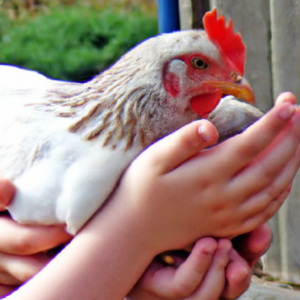
Have you ever wondered why chickens love taking dust baths? Well, it turns out that providing them with a dust bath area is essential for their health and well-being. Not only does it help keep their feathers clean and free from parasites, but it also serves as a natural way for them to relax and alleviate stress. In this article, we will explore the importance of dust baths for chickens and why creating this designated space is crucial for their overall happiness and health. So, let’s dive in and learn all about the significance of dust baths for our feathered friends!

Benefits of a Dust Bath Area
Prevents External Parasites
A dust bath area plays a crucial role in preventing external parasites in chickens. When chickens engage in a dust bath, they actively coat themselves in dry soil or dust, which suffocates and removes any potential pests such as mites, lice, and fleas. These parasites can cause discomfort and health issues for the birds, leading to reduced egg production and overall poor health. By providing a designated dust bath area, you can help ensure that your chickens stay parasite-free and healthy.
Maintains Feather Health
Regular dust baths contribute to the maintenance of feather health in chickens. Chickens naturally produce oil from a gland near the base of their tail feathers. When they engage in a dust bath, they spread this oil throughout their feathers, effectively moisturizing and conditioning them. Additionally, as the chickens roll and flick the dust onto their feathers, it helps remove excess oils, dirt, and debris that might otherwise accumulate. This process helps keep the feathers clean, healthy, and properly insulated, promoting optimal feather growth and overall bird health.
Reduces Stress
Providing a dust bath area for your chickens can significantly reduce their stress levels. Chickens are inherently curious and active animals, and a dust bath offers them a natural outlet for their energy. Engaging in a dust bath allows chickens to exhibit their natural behaviors and instincts, which in turn helps them relax and alleviate stress. This is particularly important for confined or backyard chickens that may not have access to a spacious environment. By offering a dust bath area, you create a stimulating and stress-relieving activity for your feathered friends.
Promotes Exercise
A dust bath area promotes exercise for chickens, as they enthusiastically scratch, roll, and flick the dust around. These physical movements engage various muscle groups, including the legs, wings, and back, providing a form of natural exercise. Regular exercise is essential for maintaining good muscle tone and preventing obesity in chickens. By encouraging your chickens to engage in a dust bath, you are promoting their physical fitness and overall well-being.
Provides a Natural Behavior
Chickens have an instinctual need to engage in dust baths. In their natural habitat, they would find suitable areas to carry out this behavior. By providing a dedicated dust bath area, you are meeting their fundamental need and allowing them to exhibit their natural behaviors. This not only enhances their overall happiness and well-being, but it also helps them lead more fulfilling lives.
Enhances Preening Ability
Dust baths also enhance chickens’ preening ability. Preening is the process in which birds clean and groom their feathers using their beak and feet. The dust particles help to absorb excess oils and dirt from the feathers, making them easier to clean. When chickens engage in a dust bath, they coat their feathers with dust particles and then use their beaks and feet to distribute the particles throughout their feathers. This action helps to maintain the integrity of the feathers, keeping them in optimal condition for insulation and flight.
Regulates Body Temperature
A dust bath area allows chickens to regulate their body temperature effectively. Chickens do not have sweat glands, so they rely on other mechanisms to cool down in hot weather. One of these mechanisms is by taking a dust bath. The dust particles on their feathers absorb moisture and create a layer of insulation. As the moisture evaporates, it helps to cool down the chickens’ bodies. In colder weather, the dust can help insulate their feathers and retain body heat. By offering a dust bath area, you enable your chickens to regulate their body temperature naturally, ensuring their comfort and health.
Improves Soil Quality
Creating a dust bath area is not only beneficial for your chickens but also for the environment. The constant scratching and movement of the soil in the dust bath area provides a natural form of aeration, improving the overall quality of the soil. The chicken’s interaction with the soil promotes drainage, prevents compaction, and helps break down organic matter. As a result, the soil becomes healthier, more fertile, and better suited for gardening or other agricultural purposes.
Reduces Odor and Ammonia
A well-maintained dust bath area can help reduce odor and ammonia levels in your chicken coop or run. When chickens engage in a dust bath, the dust particles absorb excess moisture and eliminate foul odors. Additionally, the drying effect of dust baths prevents the buildup of ammonia, a byproduct of chicken waste. Ammonia can be harmful to your chickens’ respiratory system, so providing a dust bath area helps to minimize its presence. By incorporating a dust bath area into your chicken-keeping routine, you can maintain a fresher-smelling, healthier environment for both yourself and your feathered friends.
Encourages Social Interaction
A dust bath area can also foster social interaction among your chickens. Chickens are social creatures and enjoy spending time together. When one chicken discovers a dust bath, it is likely to attract other flock members, initiating a communal dust bathing session. This shared activity strengthens social bonds and promotes a sense of unity within the flock. Furthermore, dust bathing can help establish and reinforce the hierarchy within the pecking order, as higher-ranking chickens often take priority in the dust bath area. By providing a dedicated dust bath area, you create an opportunity for your chickens to engage in positive social behavior.
How to Create a Dust Bath Area
Choosing the Location
Selecting the right location for your dust bath area is crucial. Ideally, it should be a well-drained area with loose soil or sandy ground. The location should also be easily accessible for your chickens without causing disturbance to the rest of their living space. Consider placing the dust bath area under partial shade to provide protection from excessive heat or rain. Additionally, ensure that the area is away from food and water sources to prevent contamination.
Preparing the Area
Once you have chosen the location, it’s time to prepare the dust bath area. Start by removing any rocks, debris, or vegetation that could interfere with the dust bathing process. Ensure that the area is level and free from any obstructions that could cause injuries to your chickens. If the soil is particularly compacted, you may need to loosen it using a garden rake or tiller. Aim for loose, crumbly soil that your chickens can easily dig into.
Selecting Bathing Materials
The primary material for a dust bath area is dry soil or dust. Chickens prefer fine, sandy soil, as it easily adheres to their feathers and effectively cleans them. You can also incorporate other materials such as wood ash, diatomaceous earth, or sand to enhance the dust bathing experience. Wood ash has the added benefit of deterring external parasites, while diatomaceous earth helps control pest infestations. Avoid using clay or muddy soil, as it may cake onto the feathers and cause discomfort.
Maintaining the Dust Bath Area
Regular maintenance of the dust bath area is essential to ensure its continued effectiveness. Periodically replenish the dusting material, especially if it becomes clumpy or soiled. Remove any feces, feathers, or debris that may accumulate in the area to maintain cleanliness. If the area becomes excessively muddy or compacted, you may need to temporarily relocate the dust bath or add more soil and sand for your chickens’ comfort. Keeping the area well-maintained will ensure that your chickens can enjoy their dust baths to the fullest.

Preventing Common Issues
Avoiding Soil Contamination
To prevent soil contamination, it is crucial to keep the dust bath area separate from your chickens’ food and water sources. Chickens naturally scratch and kick up dust, which could potentially contaminate their food or water if situated too close. Placing barriers or using fencing can help create a clear boundary between the dust bath area and the feeding and watering stations. Regular litter replacement in the coop or run can also prevent cross-contamination between the dust bath area and the rest of the living space.
Preventing Mud and Moisture
To prevent mud and excessive moisture in the dust bath area, ensure that the location has good drainage. Avoid areas prone to pooling water or where rain runoff accumulates. If necessary, create a raised or slightly sloped area to ensure proper water drainage. Periodically monitor the moisture levels in the dust bath area and adjust the amount of soil or sand accordingly. Maintaining a dry and airy environment will prevent mud formation and ensure an optimal dust bathing experience for your chickens.
Managing Dust Bath Location
It is essential to consider the overall management of the dust bath location to prevent issues such as erosion or soil depletion. If your chickens are frequently digging up the soil to the point where erosion becomes a concern, you may need to rotate the dust bath area periodically. This will allow the soil to recover and regenerate. Additionally, if the soil becomes nutrient-depleted over time, consider incorporating organic matter or compost into the area to replenish nutrients and maintain soil health.
Monitoring External Parasites
While dust baths help prevent external parasites, it’s important to remain vigilant and monitor your chickens for any signs of infestation. Conduct regular health checks and inspections to identify potential pest issues early on. If you notice excessive scratching, feather loss, or changes in behavior, it may indicate a pest infestation. In such cases, consult with a veterinarian or poultry specialist to determine the appropriate course of action. Remember, dust baths are preventative measures and may not completely eliminate the risk of parasites, especially if the infestation is already present in the flock.
Frequently Asked Questions
How often should chickens take a dust bath?
Chickens should have access to a dust bath area at all times, allowing them to take a dust bath whenever they feel the need. Chickens generally engage in dust baths multiple times a day, especially during daylight hours, as it helps them maintain their feather health and alleviate stress. By providing a constant dust bath area, you empower your chickens to regulate their grooming and well-being independently.
Can chickens use sand as a dust bath?
Absolutely! Sand is a commonly used material in dust baths for chickens. It provides an excellent texture that chickens prefer, allowing them to effectively clean their feathers. Sand is easy to source, relatively inexpensive, and readily available. Additionally, it naturally aids in reducing external pests and offers good drainage. If using sand, ensure that it is clean, free from contaminants, and regularly replenished to maintain its effectiveness.
What if I don’t have enough space for a dust bath area?
If space is limited, consider using a small, portable container as a makeshift dust bath area. You can repurpose a shallow plastic tub, storage bin, or even a large litter box to create a compact dust bath. Fill it with suitable dusting material, such as fine soil or sand, and place it in an area accessible to your chickens. While it may not be as spacious as a dedicated dust bath area, it still provides an opportunity for your chickens to engage in this essential behavior.
Can young chicks use a dust bath?
Young chicks can also benefit from dust baths, although their bathing needs may differ slightly from adult chickens. Provide a shallow pan or container filled with fine, dry soil or sand for their dust bathing pleasure. Ensure that the container is low enough for them to access easily without the risk of injury. Supervise their dust bath sessions initially to ensure their safety and comfort. As they grow, they will become more independent in their dust bathing routine.
Are there any alternative methods for providing dust baths?
If a traditional dust bath area is not feasible for your situation, there are alternative methods for providing dust baths to your chickens. For example, you can use a dust bath mix consisting of diatomaceous earth, wood ash, and sand, which can be sprinkled in their coop or run. Alternatively, you can provide soft, dry, grassy areas where chickens can engage in natural dusting behaviors. The key is to offer chickens opportunities to engage in these natural behaviors in whichever way is practical for your specific circumstances.

Conclusion
Providing a dust bath area for your chickens is essential for their overall health, well-being, and happiness. A dust bath area offers numerous benefits, from preventing external parasites to promoting exercise and social interaction. By following the recommended guidelines for creating and maintaining a dust bath area, you can ensure that your chickens have a safe and enjoyable space to fulfill their innate instinct for dust bathing. Remember to monitor for potential issues and make necessary adjustments to provide the best dust bathing experience for your feathered friends.







